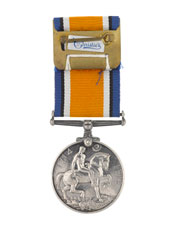
Online Collection
British War Medal 1914-20 awarded to Captain Newton Williams
Silver campaign medal with a portrait of King George V facing left with the inscription, 'Georgivs V Britt: Omn: Rex Et Ind Imp:', on the obverse and an equestrian figure of St George, trampling a shield bearing the Prussian eagle, on the reverse. Additional designs on the reverse include the years, '1914' and '1918', a skull and crossed bones representing death and a rising sun, representing victory. Orange corded silk ribbon edged with blue and white vertical stripes.
Williams was appointed second lieutenant in the Special Reserve in March 1915. Posted to 3rd Battalion The Gloucester Regiment, he was soon promoted to temporary captain and transferred to the 1st Battalion. He proceeded to the Western Front in October 1915.
In January 1916 he embarked for the Mesopotamian theatre, initially serving as a staff officer at the Expeditionary Force's headquarters in Basra. In May 1916 his knowledge of Persia and its people resulted in a transfer to the South Persia Rifles. In October 1916 he was given command of the Rifles' 5th Infantry Battalion, and in February 1917 he took over the 3rd Infantry.
In January 1918 Williams was appointed Deputy Assistant Quarter Master General, Lines of Communication. Promoted to temporary major on 19 August 1918, he remained in this post for the remainder of the War.
The British War Medal was awarded to all members of the British and Imperial military forces who completed 28 days mobilised service during 1914-1918. Although World War One ended in 1918, the qualification period for this medal was extended to cover post-war ordnance clearance and service in Russia during 1919-1920. Over six million of these medals were issued to British and Empire soldiers.
NAM Accession Number
NAM. 2007-03-66-3
Copyright/Ownership
National Army Museum, Out of Copyright
Location
National Army Museum, Study collection
Object URL
https://collection.nam.ac.uk/detail.php?acc=2007-03-66-3


